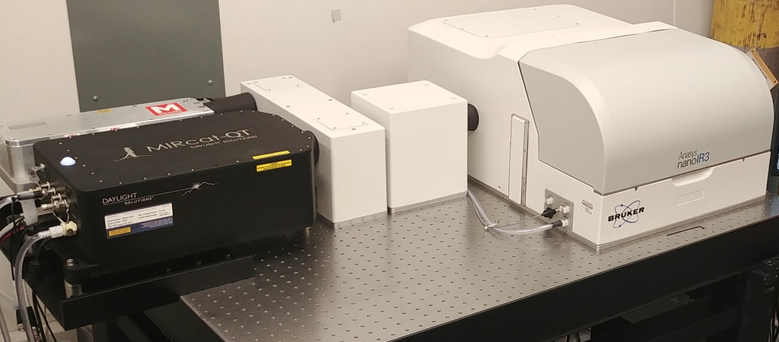Bruker/Anasys NanoIR3
1-214 Nils Hasselmo Hall
Specifications:
- Small sample SPM (must fit on conventional 15mm AFM disk) but on motorized stage (travel range: 8 mm in X and 6 mm in Y).
- Motor and scanner share digital coordinate system that is retained from all images in a session (such that the locations of images and spectra collected macroscale distances apart are recorded with microscale precision).
- Excellent video access including digital acquisition of video images, plus denotation of point locations of spectral acquisition within video images (i.e., in addition to such denotation within AFM images).
- Acoustic vibration isolation chamber on air table.
- Closed loop (XYZ) scanner, (50 x 50 x 6 µm); ambient.
- Two pulsed IR lasers (must select one):
- MIRCAT: 4 quantum cascade laser (QCL) chips. Three span a continuous interval from 904-1778 cm-1, 4th spans ~2000-2300 cm-1. All may be used in tandem.
- Firefly: optical parametric oscillator (OPO) laser spanning ~2700-3600 cm-1.
- Software Analysis Studio 3.17 provides up to 8 data acquisition channels for imaging, 4 channels for spectroscopy (force curves or IR spectra, etc.).
- Modes for imaging infrared absorption:
- Tapping: Uses heterodyne effect, whereby nonlinear tip-sample interaction spawns signal at the sum of the usual feedback oscillation frequency (fundamental flexural resonance) and the pulsed IR laser frequency; the latter is selected such that the detected signal takes advantage of the strong transfer function at higher eigenfrequency.
- Simultaneously acquired property imaging via phase (dissipation) and time-averaged cantilever deflection (0th harmonic, can be sensitive to long-range forces such as electrostatic).
- Contact mode resonance-enhanced presses tip continuously to surface pulses IR laser at contact resonance frequency, which is continually adjusted by a phase locked loop feedback circuit as contact stiffness (thus frequency) may vary from point to point on heterogenous surfaces.
- Simultaneously acquired property imaging via sliding friction force (shear dissipation) and contact resonance frequency (vertical stiffness) as tracked by the phase locked loop circuit.
- Tapping: Uses heterodyne effect, whereby nonlinear tip-sample interaction spawns signal at the sum of the usual feedback oscillation frequency (fundamental flexural resonance) and the pulsed IR laser frequency; the latter is selected such that the detected signal takes advantage of the strong transfer function at higher eigenfrequency.
- Point IR spectroscopy, optional mapping: manually select point locations (on conventional AFM images) and collect IR spectra in tapping, contact resonance or contact chirping (below resonance, monitor cantilever excitation/ringdown per location); or set up 1D or 2D array of locations for automated, programmatic collection of IR spectra in any of these modes. Hyperspectral image construction from 2D arrays.
- Multiple lock-in amplifiers, contact resonance
Accessories:
- Gold-coated tips to enhance IR intensity in near-field vicinity of tip.
- Cryo-microtome for cross sectioning samples. Double-D clamp for mounting faced samples for AFM (minimal vertical clearance for Multimode, must microtome to <1mm extending stub).
- Optional floating of thin-section samples onto flat substrates including ZnS (IR transparent). Can be important to minimize depth of excitation and whereby improve lateral spatial resolution.
